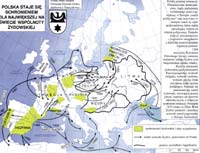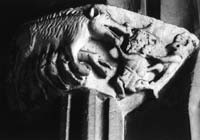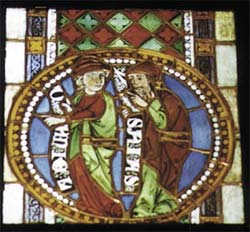





The Jewish immigration into Poland in the 11th-15th centuries.
The first Jews, who passed through Poland in the 10th century, were merchants (i.a. they engaged in very profitable slave trade). Soon persecutions forced many Jewish families to settle in Poland for good and they found there a peaceful harbour.
Hebrew brakteate from the times of Mieszko the Old with the image of bust in a helmet with a twig.
Polish prince, Mieszko III the Old, (i.a.) took advantage of the skills of the Jews in coinage; he let them out on lease his mint in Gniezno. On small, one-sided coins called brakteates the Jewish mint workers put various inscriptions in Hebrew, e.g. their own names.
Contract from the mid 11th century between the Jewish owners of the village of Mały Tyniec and silesian magnate Piotr Włostowic for the purchase of that village.
Giving high-interest loans, the jews often took over their insolvent debtors' estates. Magnates and princes were buying off pawned land from the Jews and in most cases giving it to the church.
St. Adalbert brings Jewish slave traders to prince Boleslaus (of Bohemia); casement from the door to the cathedral in Gniezno, ca. 1170. According to the annalist Gallus Anonymous, princess Judith, prince Wladislaus I Herman's wife, spent her own money on buying out the Christan slaves from the Jews. |

Satirical relief representing Jews with a sow. Capital from the kathedral in Gniezno, 2nd half of the 14th century.
The Jews didn't eat pork because they considered it unclean. According to Talmud a pig is the only even-toed ungulate that doesn't ruminate and because of that one cannot regard it kosher. Representing Jews with a pig was therefore a form of mockery of their customs.
Kazimierz near Kraków - one of the biggest Jewish communes in the medieval Poland. Engraving from the work of H. Schedl Liber Chronicorum (Nürnberg 1493).
In the major Polish towns there appeared districts inhabited exclusively by the Jews. At the end of the 15th century, after the expulsion of the Jews from Kraków, in nearby Kazimierz there was established major Jewish commune that could boast an imposing brick synagogue.
Jewish merchants thrown out of the temple by Jezus. Polyptych from the church of St. Catherine in Kraków, ca. 1470. The Jews offered bank services, exchanged money and helped to estimate its real value, making substantial profits out of it. Some of them, for instance Lewko of Kraków became bankers of kings and princes.
Image of the female Jew, Esther, who according to the legend was a mistress of King Casimir the Great. The only mention of beautiful Esther, supposed lover of King Casimir, one can find in the chronicle of Jan Długosz (died 1480). The romance is said to bear fruits in the form of two sons. The annalist claimed that it was due to Esther's intercession, that the Polish Jews enjoyed nomerous privileges. |

Jews in prayer robes. Stained-glass window from the cathedral in Włocławek, ca. 1360.
Talles - rectangular, white shawl with fringes along its shorter sides, for centuries worn by the Jews during prayers. The honour of wearing it is available only for married male Jews.
The first Jews settled in Poland in the 11th-12th centuries, after the Jewish communes in Western Europe had been assaulted by the crusaders on their way to the Holy Land. Their mass inflow however has not begun untill the 14th century, when they suffered from the persecutions that followed the accusations of causing the plague epidemic, so called "black death". Kings and dukes of Poland, hoping that the Jews would contribute to the faster development of the country, took a good care of them and granted them various privileges that defined legal rights and obligations of both parties. The first charter was issued by the Prince Bolesław the Pious in 1264. Trade and craft were the main jobs of the Jewish population, and to a lesser degree - providing loans. Because of their craft skills the princes employed them at their mints. The Jews inhabited bigger towns along the major trade routes, where they erected their synagogues and cemeteries. The oldest Jewish funerary monument in Poland, dating from 1203; Wrocław. Matzeva made of white sandstone, found in 1917 in the foundation of the cathedral in Wrocław, dedicated to cantor David, son of Sar Shalom. The funerary monuments of the poorer Jews were wooden. |

